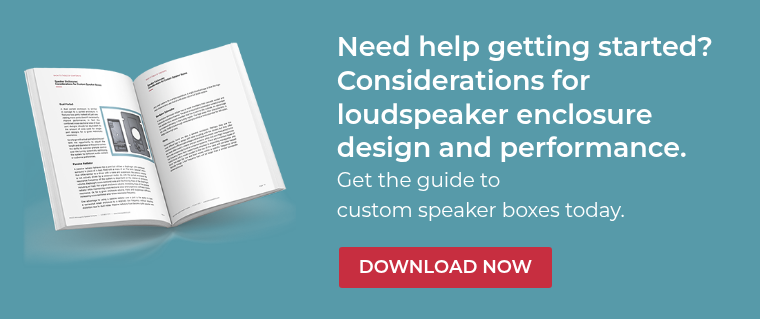How Final Speaker Testing Prevents Faulty Speaker Systems
End-of-line loudspeaker testing is the final hurdle between manufacturers and end users–and the final chance for designers to catch any defects or faults. If a manufacturer delivers faulty speakers for their customers, they’ll likely need to repair or replace them later, at added cost and damaged reputation.
Unfortunately, many speaker manufacturers (especially ones that prioritize speed over quality) skimp on these crucial steps. They may only conduct the industry standard “rub and buzz” test, a brief, single-tone test to measure overall auditory performance. If the speaker makes a sound, and it doesn't sound “bad,” they pass the speaker.
Shipping speakers based on basic auditory performance might save money in the short term, but it doesn’t ensure proper speaker performance long-term. Comprehensive factory acceptance testing is critical for effective speaker performance.
At MISCO, we conduct seven quantitative production validation tests before passing speakers to our customers, including a thorough “rub and buzz” test. This post will cover how three specific tests–Frequency Response Margin, THD Margin, and Impedance Margin–help avoid sending faulty speakers to customers.
Testing Frequency Response Margins
When a speaker is produced, its frequency response wave should fit within a tolerance window consistent with the driver’s intended purpose. Any unplanned peaks or dips can cause a testing failure–and such sound fluctuations can cause distortions in customer-facing units.
Comprehensive end-of-line frequency response testing goes beyond tracking sound fluctuations, however. It also factors in testing location, equipment, software, measurements, and real-world applications.
- Multi-axis and multi-angle approach: When testing frequency response, manufacturers should apply an objective, on-axis and off-axis approach. This helps detect frequency defects both directly in front of the speaker and at 30-degree or 60-degree angles. Off-axis measurements–to the right or left of the speaker—represent realistic positions for any listener.
- Testing location: Testing within anechoic chambers, using a sine wave signal gently swept through the audible frequency, can eliminate reflected sound signals and avoid integrating outside sounds into the response. When tested in a room free from echo and reverberation, a speaker will produce a frequency response graph depicting only the sound produced by the speaker, not the sound that reflects off the wall, ceiling, or floor.
- Real-world application. A speaker designed for voice use, like in a drive-thru lane or a kiosk, will likely be encased in a small enclosure to protect from environmental factors. Intelligibility bands also factor in the frequency response for voice speakers. Too much low frequency can garble voice sounds, and too much high frequency can make it difficult to hear for extended periods of time.
Testing frequency response at the end of the line helps manufacturers fix unexpected sound fluctuations before delivering speakers. In turn, this helps us avoid unnecessary maintenance or repair work on already-installed speakers.
Testing Total Harmonic Distortion Margins
If any part of the speaker isn’t working linearly – either from voice coil imperfections, cone problems, or transducer issues, it will create harmonic distortion. Manufacturers measure this through Total Harmonic Distortion, determined by the ratio of harmonic components compared to the fundamental frequency.
Distortion is typically measured throughout the production process, but it’s just as vital to track at the end of the line before shipment. Undetected distortion can threaten the listener’s experience or reduce voice intelligibility.
Comprehensive end-of-line harmonic distortion testing should factor in multiple distortion forms and the speaker’s mechanical components.
- Distortion forms. At MISCO, we partner with SoundCheck by Listen, Inc. to test various speaker factors–including distortion. SoundCheck collects many of these measurements from a single sine sweep. Typical distortion tests measure Harmonic Distortion (THD, THD+N), rub and buzz, loose particle detection, intermodulation distortion, non-coherent distortion, and perceptual distortion.
- Speaker components. Ideally, any mechanical issues would be addressed before a speaker reaches end-of-line testing. But it’s still worthwhile to check for failing components–damaged or misaligned voice coils and spiders, deteriorated surround, or damaged or warped cones. All these can increase distortion and affect the speaker's ability to reproduce accurate sound.
While many listeners might not notice distortion if THD is less than 1%, some musicians and audiophiles can. High THD levels can also indicate an electrical issue with the equipment–the last thing most speaker buyers want with their new systems.
Testing Impedance Margins
When properly designed for the intended application, speakers should produce an overall balanced and pleasing sound. Impedance directly affects that result, based on how much power it draws from an amplifier. Too little impedance and the speaker becomes a drain on the electrical system. Measuring impedance is crucial for multi-speaker systems working off one amp.
Comprehensive end-of-line impedance testing should factor in multiple measurements, from nominal impedance levels to phase angles.
- Nominal impedance. The speaker’s stated impedance is typically 4, 8, or 16 ohms. Specific speaker applications might call for adjusted tolerance ranges, like for outdoor-facing speakers or commercial sound placements.
- Impedance curve. If impedance spikes or drops outside of the curve (typically ranging from 20Hz to 20kHz), it could indicate problems in speaker design or construction.
- Minimum impedance. Even though most modern amplifiers have fail-safes to prevent overheating or outrages, speakers should still operate above the amp’s recommended minimum load.
- Phase angle. This measures how much heat the amplifier will dissipate with how much power it will deliver to the speaker. A phase angle that deviates significantly from the expected value can indicate issues with the speaker's crossover network or other components.
Identifying and addressing impedance issues before shipping can significantly reduce warranty claims and associated costs, reduce the likelihood of shipping faulty products, and reduce the risk of speaker damage.
Conducting a single, simple test at the end of speaker production is a risk that manufacturers shouldn’t take. At MISCO, we thoroughly test our speakers at every stage of production, including right before delivery. This helps us deliver high-quality, long-lasting speakers–with fewer returns or warranty claims.
.webp?width=1280&height=720&name=loudspeaker%20enclosure_ported%20(1).webp)
